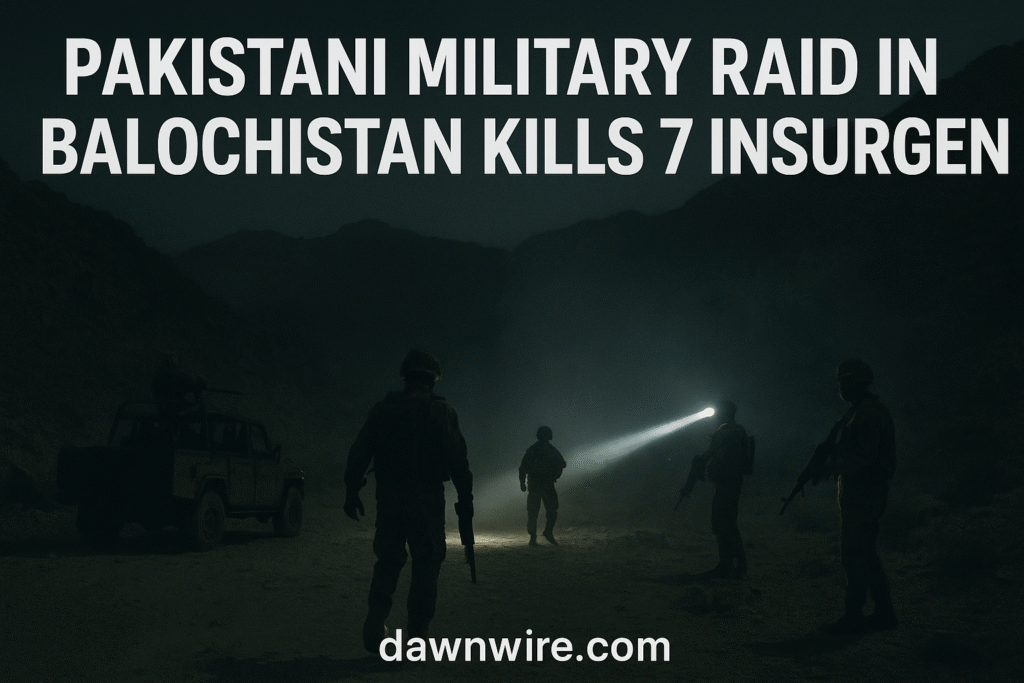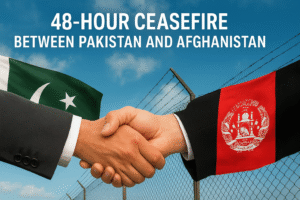Pakistani Military Raid in Balochistan Kills 7 Insurgents, Recovers Weapons

Introduction
In a major counterterrorism operation, Pakistan’s military announced the killing of seven insurgents during an intelligence-based operation (IBO) in the rugged Sherani district of Balochistan. The raid, which also led to the recovery of a significant cache of weapons and explosives, underscores the ongoing security challenges in the country’s largest but most volatile province.
The operation comes shortly after a deadly car bombing outside a paramilitary headquarters in Quetta, which claimed multiple lives and injured dozens. According to security sources, the raid targeted a cell linked to the Baloch separatist network, part of Pakistan’s long-running struggle to contain militancy and separatism in the region.
This article provides a comprehensive and factual breakdown of the event — its background, operational details, and broader implications for Pakistan’s internal security, geopolitics, and the future of peace in Balochistan. Pakistani military raid in Balochistan; Balochistan insurgency; Sherani operation; seven insurgents killed; recovered weapons; Pakistan counterterrorism; ISPR operatio.Pakistani military raid in Balochistan; Balochistan insurgency; Sherani operation; seven insurgents killed; recovered weapons; Pakistan counterterrorism; ISPR operatio.
The Raid: How It Unfolded
Operation Timeline
On the morning of October 1, 2025, intelligence reports indicated the presence of armed militants in the mountainous region of Sherani. Acting swiftly, Pakistani security forces launched a coordinated strike, surrounding suspected hideouts. The operation escalated into a fierce gun battle that lasted several hours.
When the smoke cleared, seven insurgents lay dead. The military recovered automatic rifles, ammunition belts, grenades, explosives, and communication devices from the site. All recovered materials were seized for forensic and intelligence analysis.
Target and Objective
The militants were believed to be part of the Baloch Liberation Army (BLA) and allied factions responsible for recent attacks on security personnel and infrastructure in the province. Officials stated that the group had been planning further sabotage operations aimed at destabilizing the region.
The operation’s objective was to disrupt the militant network, eliminate leadership elements, and prevent future coordinated strikes on security installations and CPEC-linked projects.
Post-Raid Assessment
Following the encounter, a sweep and sanitization process was conducted to ensure no residual threats remained. The site’s terrain — steep mountains and narrow valleys — made access challenging, yet troops successfully completed the mission without sustaining major casualties.
Military officials hailed the operation as a “significant victory against terrorism,” emphasizing that such IBOs are part of a wider strategy to ensure stability and safeguard key national projects.
Background: Insurgency in Balochistan
Historical Roots
The insurgency in Balochistan has deep historical roots. Since Pakistan’s independence in 1947, several waves of rebellion have erupted, fueled by political, ethnic, and economic grievances. Many Baloch nationalists claim that Islamabad has long ignored their province’s needs despite its resource wealth.
The first uprising began in 1948, followed by major insurgent phases in the 1950s, 1970s, and the early 2000s. Each time, the conflict was driven by demands for greater autonomy, control over local resources, and equitable development.
Economic Disparity and Marginalization
Balochistan contributes a significant portion of Pakistan’s natural gas and mineral output but remains one of the least developed regions in the country. Locals often argue that revenues from gas fields and mines benefit the federal government and other provinces more than Balochistan itself.
The lack of modern infrastructure, limited job opportunities, and perceived exploitation by outside entities have fueled resentment, providing fertile ground for separatist recruitment.
Evolution of the Insurgent Movement
Over time, militant organizations emerged with increasingly organized command structures. The Baloch Liberation Army (BLA), Baloch Republican Army (BRA), and Baloch Liberation Front (BLF) have all played key roles in sustaining the conflict.
These groups often target security forces, government offices, Chinese projects, and gas pipelines. In recent years, their tactics have evolved from hit-and-run attacks to coordinated assaults, bombings, and ambushes.
Strategic Importance of Balochistan
Balochistan is not just Pakistan’s largest province — it is also its strategic heartland.
-
Natural Resources: The province is rich in gas, coal, copper, gold, and other minerals, making it a potential economic powerhouse.
-
CPEC and Gwadar: The China-Pakistan Economic Corridor (CPEC) runs through Balochistan, connecting China’s western regions to the Arabian Sea via Gwadar Port.
-
Geopolitical Location: Sharing borders with Iran and Afghanistan, Balochistan’s position makes it critical for trade, security, and regional influence.
Any instability in the province directly affects CPEC, foreign investment, and Pakistan’s strategic partnerships, particularly with China.
The Role of Insurgent Groups
Baloch Liberation Army (BLA)
The BLA remains the most active and high-profile militant group in Balochistan. It has claimed responsibility for numerous attacks on military and civilian targets. The organization seeks complete independence for Balochistan and operates through small, decentralized cells.
Baloch Republican Army (BRA)
Formed by followers of late Baloch leader Nawab Akbar Bugti, the BRA has been involved in attacks on gas pipelines and infrastructure projects. It often cooperates with the BLA in certain areas.
Baloch Liberation Front (BLF)
The BLF focuses primarily on coastal regions and interior districts. It claims to fight for the rights of Baloch people and against what it perceives as economic exploitation.
Recent Operations Against Militants
Security forces have intensified their crackdown, conducting operations in Quetta, Awaran, Panjgur, Kech, and now Sherani. Each operation aims to dismantle local cells, recover weapons, and disrupt militant funding networks.
Recent Escalations and Attacks
The latest raid followed a surge in violence across the province. In the days preceding the operation:
-
A car bomb attack targeted the Frontier Constabulary headquarters in Quetta, killing several officers and civilians.
-
IED blasts struck convoys in Panjgur and Kech.
-
Militants attempted assaults on construction sites linked to Chinese investment projects.
The Sherani raid was seen as a direct response to these attacks, reflecting the state’s determination to prevent further escalation.
Counterterrorism Approach: Intelligence-Based Operations (IBOs)
Precision and Speed
Modern Pakistani counterinsurgency operations rely heavily on real-time intelligence. The military’s focus on IBOs allows for targeted actions that minimize collateral damage. These operations use surveillance, communication intercepts, and local informants to pinpoint militant locations.
Integration of Forces
The army, paramilitary Frontier Corps, and intelligence agencies coordinate closely. This multi-layered approach enhances effectiveness and prevents militant escapes through border corridors.
Sanitization Process
After each raid, troops conduct a “sanitization sweep” to clear remaining threats, dismantle bunkers, and collect evidence. This method prevents militants from re-establishing safe zones.
The Human Element: Civilians in the Crossfire
Challenges for Locals
While operations target insurgents, civilians often face the fallout — displacement, fear, and restricted movement. In remote regions like Sherani, access to hospitals, schools, and communication remains limited.
Many residents find themselves caught between militant coercion and military pressure. Ensuring that humanitarian needs are met during and after such operations remains a major challenge.
Human Rights Concerns
Rights groups have repeatedly called for greater transparency and accountability in counterterrorism operations. Allegations of enforced disappearances, extrajudicial detentions, and media restrictions have occasionally surfaced. The government insists that all actions are lawful and necessary to ensure national security.
Allegations of Foreign Involvement
Pakistani authorities have often accused external actors, particularly India, of aiding insurgent elements in Balochistan. Officials claim that foreign intelligence agencies use financial and logistical means to fuel separatism.
India has consistently denied these allegations, asserting that Balochistan’s unrest is an internal matter for Pakistan. Analysts believe that while regional rivalries play a role, internal grievances remain the primary driver of the conflict.
Regional Dimensions and Border Issues
Iran and Afghanistan
Balochistan shares long and porous borders with both Iran and Afghanistan. Militants have reportedly moved across these frontiers, using tribal connections and rugged terrain for cover.
In early 2024, Pakistan even launched cross-border strikes in Iran’s Sistan-Baluchestan region, targeting camps of armed Baloch separatists accused of cross-border attacks. Such incidents illustrate the regional complexity of the insurgency.
Geopolitical Implications
Regional instability in Balochistan could impact not only Pakistan but also China, Iran, and Afghanistan. Securing Balochistan is therefore central to Pakistan’s national security strategy and its regional partnerships.

The Role of Development and Dialogue
Development Initiatives
To complement military operations, the government has launched several development programs — infrastructure projects, educational institutions, and economic zones — aimed at improving local livelihoods.
The Gwadar Port Free Zone, road networks, and industrial projects under CPEC are designed to create jobs and integrate Balochistan into the national economy. However, progress remains uneven, and skepticism among locals persists due to perceived lack of local ownership.
Need for Political Inclusion
Analysts emphasize that no purely military solution can succeed in ending the insurgency. Lasting peace will depend on political dialogue, reconciliation, and inclusive governance that addresses local aspirations.
Provincial autonomy under the 18th Amendment of the Constitution is seen as a step forward, but its benefits have yet to fully reach remote districts.
Pakistan’s Security Strategy and Future Outlook
Focus on Integrated Security
The military aims to sustain long-term peace through integration of intelligence, law enforcement, and socio-economic policy. Counterinsurgency is now viewed not merely as warfare but as nation-building through stability.
Technology and Modern Warfare
Advances in drone surveillance, data analysis, and communications interception have enhanced the precision of IBOs. Pakistani security agencies increasingly use satellite imagery and artificial intelligence to predict militant activity.
Community-Based Security
Authorities have introduced community policing models in some districts, engaging local elders and tribal representatives to report suspicious movements and help mediate disputes. This strengthens trust and reduces militant recruitment.
Criticism and Policy Challenges
Despite progress, challenges persist:
-
Trust Deficit: Many Baloch communities still mistrust the federal government.
-
Economic Imbalance: Resource revenues remain a point of contention.
-
Militant Adaptation: Insurgents continue to evolve their tactics, using small cells and improvised explosive devices (IEDs).
-
Media Access: Limited independent reporting makes verification of official claims difficult.
Experts argue that Pakistan must strike a careful balance — using security measures where necessary while advancing reforms that promote fairness, transparency, and inclusion.
Wider Implications
For National Security
The Sherani operation demonstrates Pakistan’s continued commitment to countering insurgency. Each successful raid weakens militant logistics and deters attacks on critical infrastructure.
For Economic Projects
Ensuring the safety of CPEC routes and foreign investment remains a top priority. Investors closely monitor the situation in Balochistan as a barometer of Pakistan’s stability.
For Regional Diplomacy
By stabilizing Balochistan, Pakistan can improve its diplomatic leverage in South Asia, strengthen border management with Iran and Afghanistan, and enhance cooperation with China on long-term projects.
Lessons and Path Forward
The Sherani raid reinforces a central lesson: military victories must translate into lasting peace. To achieve that, Pakistan must:
-
Address root causes through equitable development and political inclusion.
-
Improve governance by empowering local bodies and reducing corruption.
-
Strengthen human rights oversight to prevent misuse of force.
-
Enhance regional diplomacy to deny militants any external sanctuaries.
-
Invest in youth and education to create alternatives to militancy.
Only through a blend of security, development, and justice can the province move from insurgency to integration.
Conclusion
The Pakistani military’s successful raid in Sherani, Balochistan, marks another chapter in the long and difficult struggle against militancy. The operation’s outcome — seven insurgents neutralized and weapons recovered — reflects both tactical capability and ongoing challenges.




